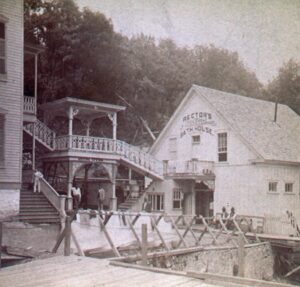
History
Originally established by Congress as Hot Springs Reservation in 1832 and later becoming a national park in 1921, Hot Springs National Park represents the oldest protected area in the National Park System.
The first non-Native American known to see the hot springs was Hernando de Soto in 1541.
In 1673 Father Marquette and Jolliet explored the area and claimed it for France. The Treaty of Paris 1763 ceded the land back to Spain; however, in 1800 control was returned to France until the Louisiana Purchase of 1803.
In November 1864 during the American civil war, a large part of ” The Valley” (the central portion of the city along Hot Springs Creek) was burned – presumably by Union troops.

The Dunbar-Huntar Expedition came here in 1804, sent by President Thomas Jefferson to explore the southern reaches of the Louisiana Purchase. Soon a bustling town grew up around the hot springs to provide services for health seekers. The resultant bathing industry led to Hot Springs becoming known as the “American-Spa”.
Hot Springs National Park is the oldest park managed by the National Park System.
Until the re-designation of Jefferson National Expansion Memorial. As Gateway Arch National Park in 2018, it was the smallest national park by area in the United States.
Many Centuries ago, The Native Americans came to a specific part of Arkansas to experience what they have believed is to be healing waters from these Hot Springs.
People nowadays still believe in such a thing, and that’s what makes them want to come and enjoy The Hot Springs in Arkansas.
It was established many years ago before the concept of a National Park existed, it was also the first time that a piece of land had been put aside for the federal government to use as an area for recreation.
The Hot Springs National Park also covers an area of 22.5 square kilometers (9 square miles) or 2,250 Hectares(5,550 acres). In 1921 Hot Springs reservation became hot Springs National Park and the area it encompassed was expanded by 900 acres Until it was later enlarged to its current size.

By the 1830s, log cabins and stores have been built for the visitors of the Hot Springs.
For them to protect this unique national resource and preserve it for the use of the public the Arkansas territorial legislature had requested in 1820 that the springs and adjoining mountains be set aside as a federal reservation.
On April 20, 1832, President Andrew Jackson signed legislation to set aside four sections of the land to reserve it for the future disposal of the United States which will not be entered and located, or appropriated, for any other purpose whatsoever.

After establishing the department of the interior in 1849, The reservation was placed under the control of the Secretary of the interior. By the mid-1800s the springs were being claimed by several private citizens. Eventually, the conflicting claims led to a series of lawsuits, and in 1877 the court ruled against all of the original claimants, reestablishing government control over the area.
Just as Hot Springs Reservation was reestablished as government property, a devastating fire swept up the valley, destroying most of the south and central downtown area but leaving the Arlington and Grand Central Hotels, the Hale, Rector, and Big Iron Bathhouses, and the buildings to their north. Many townspeople considered the great fire of 1878 to be more a blessing than a tragedy since it cleared the way for new construction that was more substantial and attractive.

In the short period after the fire, the government established stringent standards for bathhouse construction, and the area rapidly changed from a rough frontier town to an elegant spa city. Building, landscaping, and engineering projects proceeded apace
The arch was then covered with earth, and the area above it was landscaped to create a pleasing park bounded with Lombardy poplars. The new Victorian bathhouses built between 1880 and 1888 were larger and more luxurious than could have been dreamed of ten years earlier. The haphazardly placed wooden troughs carrying the thermal water down the mountainside were replaced with underground pipes. Roads and paths were improved for the convenience of visitors who wished to enjoy the scenery.
By 1901 all of the springs had been walled up and covered to protect them. Between 1912 and 1923 the wooden Victorian bathhouses built in the 1880s were gradually replaced with fire-resistant brick and stucco bathhouses, several of which featured marble walls, billiard rooms, gymnasiums, and stained glass windows. The final metamorphosis of Bathhouse Row was completed when the Lamar Bathhouse opened its doors for business in 1923. The bathhouses, all of which are still standing today, ushered in a new age of spa luxury.


